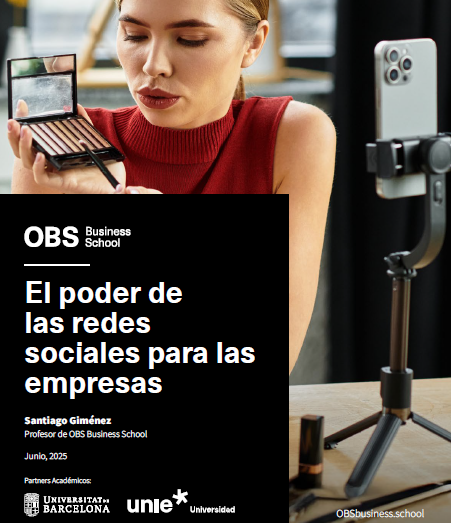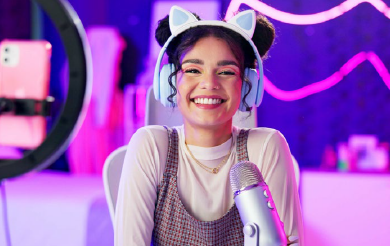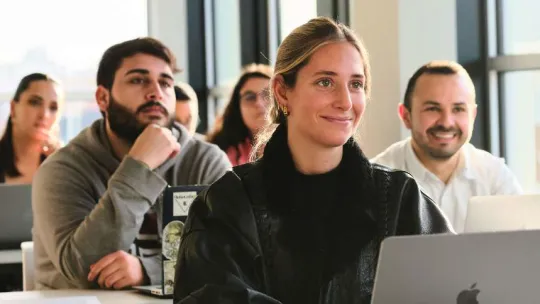
OBS Report: The Strategic Impact of Social Media on Businesses
Social media now shapes the organizational structure of many companies

- 87.1% of the Spanish population uses social media (5.3 billion users worldwide). TikTok has particularly strong penetration in Andalusia, while Facebook and Instagram are more popular in Castile and León. The regions where people spend the most time on social media are the Canary Islands, Cantabria, and Murcia.
- Social media also shapes the organizational structure of many companies: brands like Dior, Puma, Valentino, LVMH, and L'Oréal use virtual influencers with massive followings.
- Among Spanish companies, the use of Nano and Micro-Influencers is increasing. Their audiences are smaller but highly engaged. There is still significant room for growth among SMEs.
- A report by OBS considers it necessary to start measuring the real impact of campaigns beyond likes or superficial views.
July 2025. OBS Business School, an institution that is part of the Planeta Formación y Universidades higher education network, publishes the report The Power of Social Media for Businesses, directed by Professor Santiago Giménez.
"The report analyzes the consolidation of social media as strategic tools in corporate communication, customer service, sales, talent recruitment, and crisis management. It highlights the rise of virtual influencers, the growing use of micro and nano-influencers, and the need to redefine digital impact metrics beyond 'likes' and views. Spain is positioned as a highly active digital market, with development opportunities especially among SMEs.
Social media has evolved from a personal to a business tool, with over 5.3 billion global users and high penetration in Spain (87.1%), establishing itself as a key platform for business and influence.
The emergence of new profiles such as virtual influencers and the growing use of content creators with small but engaged communities are redefining the way brands communicate with their audiences.
The Global Digital Ecosystem
The use of social media continues to grow worldwide, surpassing 5.3 billion users. These platforms have become key channels for communication, sales, and brand building. In contrast to the decline of traditional advertising, content creators have managed to establish close and credible relationships with their audiences.
Influencer marketing is entering a new phase driven by artificial intelligence. This technology not only transforms campaign management but also reshapes the strategic role of social media. The change is not only technological, but also cultural, ethical, and organizational.

Organizational Transformation in Companies
Social media has become an essential tool in the business environment: it enables brand building, customer service, loyalty generation, traffic driving, direct sales, talent recruitment, and crisis management. Additionally, it acts as a “social filter” that influences purchasing processes and corporate decision-making.
Many companies already reflect this influence in their organizational structure by incorporating dedicated areas for social media, influencer marketing, and digital innovation. Its strategic relevance is expected to continue growing in the coming years.
Virtual Influencers: A New Digital Era
One of the most disruptive phenomena is the emergence of virtual influencers—digital characters created through 3D modeling, animation, and artificial intelligence. They publish content, interact with followers, promote brands, and participate in global events and campaigns.
Notable Examples:
- Lil Miquela (@lilmiquela): Over 2.5 million followers on Instagram; has collaborated with Calvin Klein, Prada, and Samsung.
- Shudu (@shudu.gram): Considered the first digital supermodel; has worked with Balmain and Fenty Beauty.
- Imma (@imma.gram): A Japanese influencer with a kawaii aesthetic; has been the face of IKEA, Puma, and Valentino.
- Noonoouri (@noonoouri): A high-fashion activist; has collaborated with Dior, Versace, and Marc Jacobs.
These digital avatars have real communities and engagement levels comparable to those of human influencers. Many brands are integrating them not only into marketing campaigns but also as part of their strategy in the metaverse and immersive environments.
Overview in Europe and Spain
Europe is one of the most advanced and regulated digital ecosystems. In this context, Spain stands out for its high digital penetration, intense social media activity, and a growing influencer market.
- 87.1% of the Spanish population are active users (more than 41 million people).
- The average daily usage time is 1 hour and 53 minutes.
- Regions such as the Canary Islands, Cantabria, and Murcia exceed 27 hours per month, while Catalonia, Madrid, and the Basque Country average around 22 hours.
- The most used platforms are YouTube, WhatsApp, Instagram, TikTok (with particularly strong penetration in Andalusia), and Facebook (more popular in Castile and León).
Influencer marketing in Spain is becoming established as a strategic channel in sectors such as consumer goods, technology, fashion, tourism, and food. The use of micro-influencers (between 10,000 and 100,000 followers) and nano-influencers (fewer than 10,000) has increased, as they connect more effectively with local audiences and specific niches.
28.7% of Spanish companies already use AI as part of their commercial or communication strategy. However, there is still room for improvement, especially among SMEs and local agencies. The fashion and beauty sector is leading this process.
Beyond data and technology, the way companies adopt AI and build influencer strategies is deeply influenced by the digital culture and economic conditions of each region in which they operate. In Spain, values such as authenticity and transparency are essential for connecting with the public. Another local trend is the creation of short, emotional, and visual content.
The OBS report highlights the need to measure the real impact of campaigns beyond 'likes' or superficial views.
Measuring only likes, shares, and comments provides a partial view; the key is to assess brand recall, positioning, and purchase intent, says Professor Santiago Giménez.
Content written by:
Carmen García-Trevijano
OBS Business School's Press Office



